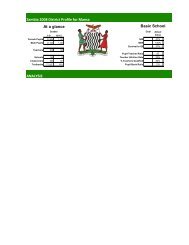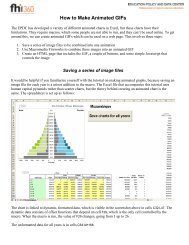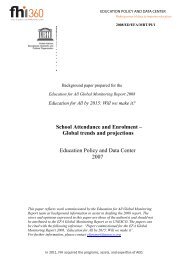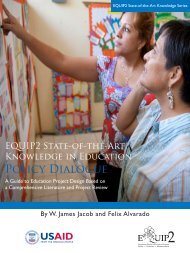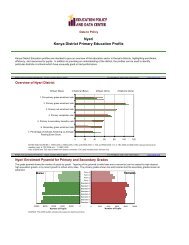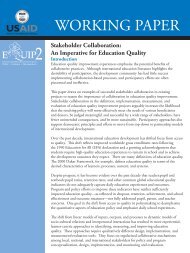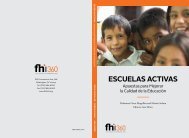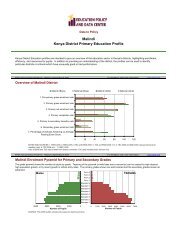Public Expenditure Tracking in Education - Education Policy Data ...
Public Expenditure Tracking in Education - Education Policy Data ...
Public Expenditure Tracking in Education - Education Policy Data ...
Create successful ePaper yourself
Turn your PDF publications into a flip-book with our unique Google optimized e-Paper software.
POLICY BRIEF<strong>Public</strong> <strong>Expenditure</strong> <strong>Track<strong>in</strong>g</strong> <strong>in</strong> <strong>Education</strong>Develop<strong>in</strong>g countries have <strong>in</strong>creased spend<strong>in</strong>g on primary-secondary education <strong>in</strong> recentyears to fulfill their commitment to quality education for all. However, several countrieshave been disappo<strong>in</strong>ted <strong>in</strong> the results of their additional <strong>in</strong>vestments and have begunto explore the reasons for the meager ga<strong>in</strong>s. The <strong>Public</strong> <strong>Expenditure</strong> <strong>Track<strong>in</strong>g</strong> Survey(PETS) has been an important tool <strong>in</strong> these <strong>in</strong>vestigations.ObjectivesPETS is a method to study the flow of public funds and other resources, with theaims of measur<strong>in</strong>g how much government fund<strong>in</strong>g actually reaches the classroom andidentify<strong>in</strong>g the major po<strong>in</strong>ts of resource leakage and misuse. All public educationfund<strong>in</strong>g has f<strong>in</strong>ancial audit<strong>in</strong>g mechanisms to ensure accountability for its appropriateuse. PETS can also help policymakers diagnose how these accountability systems arework<strong>in</strong>g <strong>in</strong> practice and how they can be improved. Accountability systems oftenwork best when <strong>in</strong>formation on f<strong>in</strong>ancial and resource flows is easily available to allstakeholders <strong>in</strong> the system. Thus, dissem<strong>in</strong>ation of PETS results may <strong>in</strong> and of itselfhelp improve accountability and set <strong>in</strong> motion the steps required to reduce <strong>in</strong>efficient useof funds. Governments and other stakeholders are responsible for mak<strong>in</strong>g adm<strong>in</strong>istrativereforms and mobiliz<strong>in</strong>g civil society to render PETS recommendations a reality.<strong>Data</strong>PETS obta<strong>in</strong>s data through a series of sample-based surveys and <strong>in</strong>terviews carried out atevery po<strong>in</strong>t at which decisions are made about education resources. The most importantof these, the school survey, documents the source and use of education resources. Theschool survey is complemented by questionnaires that accurately determ<strong>in</strong>e the flow offunds at the national, regional, and local levels. In many cases, education f<strong>in</strong>ance is socomplex and lack<strong>in</strong>g <strong>in</strong> transparency that simply show<strong>in</strong>g the flow of funds contributesto an understand<strong>in</strong>g of the <strong>in</strong>centives and opportunities to prevent leakage <strong>in</strong> the system.The major questions a country wishes to answer about its education system determ<strong>in</strong>ethe specific data collected by PETS—some are comprehensive while others ma<strong>in</strong>ly focuson a particular resource or leakage.EQUIP2 is funded by theUnited States Agency forInternational DevelopmentCooperative AgreementNo. GDG-A-00-03-00008-00The Quality of Service Delivery Survey (QSDS) is an especially comprehensiveschool-level survey that goes beyond the measurement of resource flows to evaluatecharacteristics of service delivery. Most PETS <strong>in</strong>clude QSDS, although a school-levelsurvey like QSDS can be carried out <strong>in</strong>dependently of PETS.ResultsPETS results may <strong>in</strong>clude leakage estimates, <strong>in</strong>formation about the percentage offunds spent at each level of the education hierarchy, and descriptions of how fund<strong>in</strong>g istargeted among different schools and subpopulations. School survey questionnaires can
Lessons LearnedPETS is a potentially powerful tool for reveal<strong>in</strong>g leakage and corruption <strong>in</strong> educationf<strong>in</strong>ance. The survey and analysis must be undertaken by local, <strong>in</strong>dependent researchersnot affiliated with the m<strong>in</strong>istry of education to ensure the credibility of results.Conversely, education and f<strong>in</strong>ance m<strong>in</strong>istry personnel must serve on the advisorycommittee oversee<strong>in</strong>g PETS to guarantee ownership and follow-through on the results.Collaboration with the press to dissem<strong>in</strong>ate results is also essential.The cost of conduct<strong>in</strong>g PETS varies with the number and complexity of the questionsbe<strong>in</strong>g asked and the size and population of the country. To date, costs have ranged fromUS$50,000 to well over US$100,000. However, these costs are very small relative tothe magnitude of resource leakage uncovered <strong>in</strong> most countries. Most PETS have beencarried out with the technical assistance of The World Bank, but a grow<strong>in</strong>g numberof develop<strong>in</strong>g country survey firms and nongovernmental organizations have acquiredexperience <strong>in</strong> sampl<strong>in</strong>g, survey <strong>in</strong>strument development, survey adm<strong>in</strong>istration, andresult<strong>in</strong>g data analysis. PETS can be carried out more quickly and at lower cost as localexperience and expertise grow.Rates of Teacher AbsenteeismBangladesh16%Ecuador14%Honduras14%India25%Indonesia19%Papua New Gu<strong>in</strong>ea15%Peru11%Uganda (PETS II)27%Zambia17%ReferencesConsistent with the transparency of <strong>in</strong>formation that is the objective of PETS, thesampl<strong>in</strong>g frame, questionnaires, and analyses of data from each of the PETS carried outunder the auspices of The World Bank can be found at http://www1.worldbank.org/publicsector/pe/track<strong>in</strong>gsurveys.htm. Additional <strong>in</strong>formation can be found <strong>in</strong> <strong>Public</strong><strong>Expenditure</strong> <strong>Track<strong>in</strong>g</strong> Surveys <strong>in</strong> <strong>Education</strong> by Ritva Re<strong>in</strong>ikka and Nathanael Smith,published by the United Nations <strong>Education</strong>al, Scientific and Cultural Organization(UNESCO) International Institute of <strong>Education</strong>al Plann<strong>in</strong>g (IIEP) <strong>in</strong> 2004. IIEP andThe World Bank Institute have jo<strong>in</strong>tly developed an annual tra<strong>in</strong><strong>in</strong>g course on PETS,conducted <strong>in</strong> East Asia <strong>in</strong> 2004 and Southern Africa <strong>in</strong> 2005.3
<strong>Public</strong> <strong>Expenditure</strong> <strong>Track<strong>in</strong>g</strong> <strong>in</strong> <strong>Education</strong>AcknowledgementsThis paper was written for EQUIP2 by Donald R. W<strong>in</strong>kler (Research Triangle InstituteInternational), 2005.EQUIP2: <strong>Education</strong>al <strong>Policy</strong>, Systems Development, and Management is one ofthree USAID-funded Leader with Associate Cooperative Agreements under the umbrellahead<strong>in</strong>g <strong>Education</strong>al Quality Improvement Program (EQUIP). As a Leader withAssociates mechanism, EQUIP2 accommodates buy-<strong>in</strong> awards from USAID bureaus andmissions to support the goal of build<strong>in</strong>g education quality at the national, sub-national,and cross-community levels.FHI 360 is the lead organization for the global EQUIP2 partnership of education anddevelopment organizations, universities, and research <strong>in</strong>stitutions. The partnership<strong>in</strong>cludes fifteen major organizations and an expand<strong>in</strong>g network of regional and nationalassociates throughout the world: Aga Khan Foundation, American Institutes forResearch, CARE, Center for Collaboration and the Future of School<strong>in</strong>g, East-WestCenter, <strong>Education</strong> Development Center, International Rescue Committee, JosephP. Kennedy, Jr. Foundation, Michigan State University, Mississippi Consortium forInternational Development, ORC Macro, Research Triangle Institute, University ofM<strong>in</strong>nesota, University of Pittsburgh Institute of International Studies <strong>in</strong> <strong>Education</strong>,Women’s Commission for Refugee Women and Children.For more <strong>in</strong>formation about EQUIP2, please contact:USAIDPatrick Coll<strong>in</strong>sCTO EGAT/EDUSAID Wash<strong>in</strong>gton1300 Pennsylvania Ave., NWWash<strong>in</strong>gton, DC 20532Tel: 202-712-4151Email: pcoll<strong>in</strong>s@usaid.govFHI 360John GilliesEQUIP2 Project Director1825 Connecticut Ave., NWWash<strong>in</strong>gton, DC 20009Tel: 202-884-8256Email: equip2@fhi360.orgWeb: www.equip123.net4



